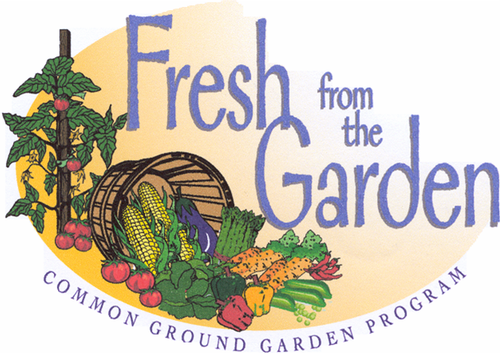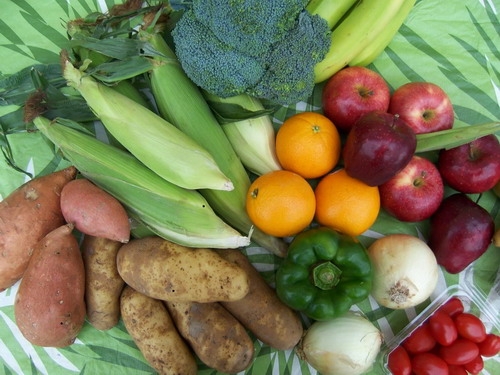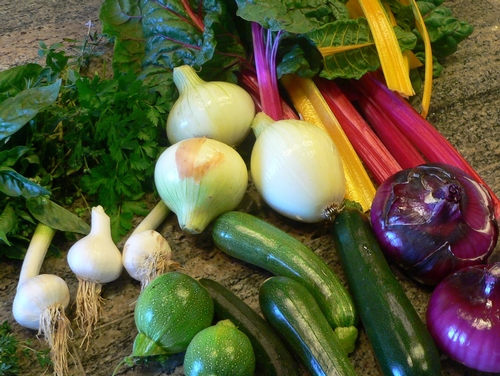Posts Tagged: vegetables
UC revives “Fresh from the Garden” materials
“Fresh from the Garden” is a “vegetable education” program that was created several years ago by retired LA County Cooperative Extension employee and registered dietitian Susan Giordano. Giordano created lessons to reach home gardeners and their families living with limited resources. The lessons are designed to increase gardeners' knowledge of healthful eating habits, while emphasizing the health benefits associated with a vegetable-rich diet. The lessons also encourage gardeners to grow a greater variety of vegetables, more nutrient-dense vegetables, to cultivate vegetable crops throughout the year, and to prepare their harvest using delicious, nutritious recipes. In recent months, the lessons have been given a makeover and updated to reflect current dietary recommendations.
Bringing nutrition education into the garden
The LA County Food Stamp Nutrition Education Program (FSNEP) is partnering with UC Master Gardener volunteers this summer to pilot the revamped lessons in the garden. A group of enthusiastic Master Gardeners with an interest in nutrition education attended a “Fresh from the Garden” training on July 10. They are now equipped to take what they learned and bring it into the low-income community and school gardens where they volunteer. Our FSNEP staff members, armed with supplemental nutrition information, plan to provide additional support and expertise along the way. This is a natural fit for UC Master Gardeners who are already teaching low-income communities how to grow their own food, and UC FSNEP staff, who are providing valuable nutrition education to food stamp-eligible families. The families who benefit from these lessons will gain the knowledge and confidence they need to enjoy delicious and nutritious vegetables fresh from the garden!
“Fresh from the Garden” tips for the gardener
This time of year, gardeners are benefiting from the fruits of their labor, however, some might be overwhelmed by the sheer volume of vegetables being produced by their gardens. What to do with it all? Below is a “Fresh from the Garden” recipe for a simple summer veggie pasta sauce. Any vegetable can be substituted, and the pasta sauce can conveniently be frozen for later use.
Summer veggie pasta sauce
|
3 – 4 large tomatoes, chopped |
1 medium small onion, chopped |
|
3 cloves garlic, crushed |
1/4—1/2 cup chopped fresh basil |
|
2 medium zucchini, chopped |
2 Tablespoons oil |
|
1 small eggplant, chopped |
Salt and black pepper to taste |
|
1 medium green pepper, chopped |
|
Heat oil in a large pan over medium heat. Add onion, green pepper and garlic. Cook for 3 to 4 minutes, stirring often. Add the zucchini and eggplant. Cook for 5 minutes.
Add the tomatoes and basil. Simmer for about 20 minutes over low heat, uncovered, until slightly thick. Add salt and pepper to taste.
This recipe can be doubled or tripled and frozen in individual or family size servings. If it is not moist enough, just add water.
Interested in accessing “Fresh from the Garden” Resources? The lessons, handouts and recipes are now available on LA County's Cooperative Extension website.
For more information about “Fresh from the Garden,” please contact Los Angeles County nutrition, family & consumer sciences advisor Brenda Roche at bkroche@ucdavis.edu, (323) 260-3299.
Reasons for the seasons
California residents not only enjoy an enviable climate and diverse regions, but also a wide selection of fresh produce year around.
As consumers, we want to stretch our food budget and provide a nutritious diet to our families; but we are not always sure about how to select the best fruits and vegetables, how to store them when we get home, new ways to serve them, and the nutrition benefits they offer.
Placer-Nevada Cooperative Extension has come to the rescue! As part of the Nutrition Best program, UCCE nutrition educators have prepared "Reasons for the Seasons - Produce tips for Placer County consumers," a series of seasonal produce handouts that provide practical information for families and children on purchasing, storing, preparing and serving locally grown seasonal produce.
Each handout also includes tips for families on the importance of family meals and snacks, a couple of tasty and easy-to-prepare recipes, and a coloring page for the children.
News & Information Outreach in Spanish has started to adapt into Spanish these handouts, and produced short video clips. The first one is for strawberries.
To tickle your interest, here is a sampling of some of the tips and information you'll find:
Apples – Over 7,000 varieties have been identified, however most consumers are only familiar with half a dozen or so varieties. Munching on an apple is a tooth cleaner and a gum stimulator. Apples may last up to three months if stored correctly.
Broccoli – Its name comes from the Latin word Brachium which means "branch" or "arm." Broccoli is one of the most nutritious vegetables you can eat. Instead of loading it with a cream sauce that is high in fat, try serving it with silvered almonds, sesame seeds, toasted bread crumbs or parmesan cheese. The leaves can also be eaten and contain more beta carotene than the florets. Store broccoli in an open plastic bag in the refrigerator vegetable drawer. For boiling or steaming, use a non-aluminum pot or pan. Aluminum seems to increase broccoli's cooking odors.
Cherries – Cherries are among the best foods for a snack. The riper the cherry, the larger the size, the deeper the color and the sweeter the fruit. Sour cherries are lower in calories and higher in vitamin C and beta carotene than sweet cherries. You can extend the cherry season by freezing them. They will keep for up to a year in your freezer.
Tomatoes - Botanically, tomatoes are a fruit. This is because, generally, a fruit is the edible part of the plant that contains the seeds, while a vegetable is the edible stems, leaves and roots of the plants. Tomatoes are the leading source of vitamin C in the American diet because of the quantities we eat. Store tomatoes at room temperature for up to one week; longer if still ripening.
Potatoes - Keep the potatoes in a burlap or a brown paper bag. Do not store onions with potatoes. The gases given off by onions accelerate the decay of potatoes and vice versa.
Melons – Most melons originated in the Near East. They are a good source of vitamin A, C and potassium. Serve melons slightly chilled; if they are too cold, you'll miss their full fragrance. Ripe melons are very fragrant, and the aroma of a cut melon can penetrate and effect other foods
Cauliflower – A good source of vitamin C, potassium and fiber. It has been associated with reducing the risk of cancer. Cauliflower should not be cooked in an aluminum or iron pot. It will turn yellow if cooked in an aluminum pot, and blue-green or brown if cooked in an iron pot.
Beets – Beets come in a glistening array of color, from garnet red, to red-white striped, to deep gold, to creamy white. The entire beet, from its robust and flavorful root to its buttery green top, is sweet and delicious. To maintain firmness, cut off beet greens before storing, but leave at least an inch of the stem attached.
May and June are cherry season, so why not look for new ways to enjoy this delicious and nutritious fruit?
Cherry salsa
1/4 cup dried cherries, coarsely chopped
1- 1/3 cups tart cherries, frozen
1/4 cup red onion, finely chopped
1 tablespoon jalapeños, diced
1 clove garlic, peeled and chopped
1 tablespoon fresh cilantro, chopped
1 teaspoon cornstarch
Coarsely chop cherries. Let cherries thaw and drain, reserving 1 tablespoon cherry juice. When cherries are thawed, combine drained cherries dried cherries, onion, jalapenos, garlic, and cilantro in a medium saucepan; mix well. Combine reserved cherry juice and cornstarch in a small bowl; mix until smooth. Stir into cherry mixture. Cook, stirring constantly, over medium-high heat until mixture is thickened. Let cool. Serve with tortilla chips.
This recipe can also be served over cooked chicken or pork
Southwestern-style cherry slaw
Yield: 6 -8 servings
Slaw:
4 cups shredded green cabbage
3 cups sweet cherries, pitted and halved
2 cups torn fresh spinach leaves
1 cup shredded jicama (optional)
1 cup shredded carrot
1/2 cup snipped fresh cilantro
1/2 cup diced red onion
1 avocado, peeled and diced
Toasted pine nuts for garnish
Dressing:
2 tablespoons olive oil
2 tablespoons fresh lime juice
2 tablespoons frozen lime juice concentrate, thawed
1 jalapeno pepper, seeded and minced
1/2 teaspoon lime zest
1/4 teaspoon each chili powder, ground cumin and salt
In large serving bowl, combine ingredients for Slaw. In small saucepan, combine Dressing ingredients; heat to boil. Pour over salad and toss gently to coat. Garnish with pine nuts and serve.
Recipe: Northwest Cherries Online
Keep your fruits and veggies tasting better longer
As you returned home from the market and unloaded your sack of produce, have you ever simply admired the satisfying bounty? Enjoyed the color, texture, and aroma as cantaloupe, broccoli, carrots, tomatoes, lettuce, cherries, apricots, avocado, strawberries and more passed through your hands? But now, what to do with each item … how best to keep it fresh and tasty until you’re ready to eat it?
The Postharvest Technology Center offers free copies of an 8.5” x 11” full color poster that shows which produce items should go in your refrigerator, which items should never go in the refrigerator, and finally, which items should be ripened at room temperature and then placed in the refrigerator.
“’Storing Fresh Fruits and Vegetable for Better Taste’ is a handy tool to keep on your refrigerator,” said Beth Mitcham, center director. “Where you store your produce can have a profound effect both on how good it tastes, and how long you can keep it at an optimal state until you’re ready to serve it to your family.”
Produce marketing researchers have noted that with the current recession, shoppers are feeling guiltier than ever when they end up having to toss out fruits or veggies ‘gone bad.’
“It’s like a double guilt,” explained Dr. Roberta Cook, “not only has the shopper with the best of intentions not eaten the food they know is healthiest for them, but they have also wasted their money. Following the handling recommendations for each produce item can really improve the consumer’s experience on several levels.”
Eat your vegetables
Californians can take advantage of our abundant sunshine and temperate climate in order to grow fruit and vegetables they can truly call their own. Gardening has some very obvious rewards, giving gardeners the freshest fruits, vegetables and herbs possible. If you are a cook, adding a garden to your backyard will pay dividends all year long.
In order to get the greatest benefit of this fantastic produce, make sure you tailor your garden to your own needs. No reason to raise a beautiful crop of broccoli or swiss chard if your family won't eat it! Tomatillos may be seen as specialty crop for some, but an important part of the garden for others. Plant what you will eat, so you will eat what you plant.
As well as growing crops you will eat, think of the potential for storage for your produce. Handled correctly, both onions and garlic are receptive to long term storage. Tomatoes can be canned, herbs can be dried. Other crops like cantaloupe, honeydew, zucchini and corn are best eaten fresh. Plan your garden accordingly.
Getting your hands dirty in the garden is great- but at the end of the day, you need to eat. Cooking a fantastic dish starts with great ingredients. When those ingredients come from your own garden, things just seem to taste a bit better.
Roasted Chicken and Onions (A good way to use a lot of onions!)
6-8 chicken thighs. Bone-in, skin removed.
4 large onions yellow or red - sliced 1/4-1/2" wide
3 garlic cloves - minced
2 tablespoons olive oil
2 teaspoons salt
1/2 teaspoon pepper
1 tablespoon paprika
The following herbs to taste - recommend approximately 1/3 cup of combined chopped herbs, pick what is fresh and available in your garden.
Rosemary
Oregano
Parsley
Directions:
- Preheat oven to 450 degrees.
- Dust chicken with paprika
- In a roasting pan, casserole dish or dutch oven toss all ingredients in order to coat chicken and onions with oil and herbs
- Bake dish uncovered for 25 minutes, toss all ingredients again, and bake until done- approximately 25 minutes more. Ensure juices run clear when chicken is pierced with knife or fork.
Food: friend or foe?
Healthy eating has gotten complicated. Fresh fruits and vegetables pack the produce aisle as never before. And new food products with added health benefits are being introduced all the time. Yet the food supply, and the agricultural system that supports it, has become increasingly criticized for its impact on the waistlines of millions of people in the United States.
“Agriculture and conventional food systems have provided the basis for long and healthy lives, and much of that improvement can be traced to healthier diets,” says UC Davis plant sciences professor Alan Bennett. “At the same time, we are faced with a growing critique that conventional food systems are a significant contributor to the health crisis that developed countries are facing, particularly related to obesity and diabetes.”
This dichotomy — that agriculture is both the problem and the solution to an increasing health crisis — is the backdrop for the 22nd annual conference of the National Agricultural Biotechnology Council (NABC) at UC Davis June 16-18. The conference, “Promoting Health by Linking Agriculture, Food and Nutrition,” will examine ongoing research strategies to promote health through food and diet, as well as how governmental regulatory systems provide oversight of the relationship between food and health.
Leading food, nutrition and agricultural scientists from around the country will be participating in sessions with topics such as designing and producing healthy food, social and cultural dimensions of eating habits, bringing nutrition science to regulations, and how business can find food and nutrition innovations.
NABC has been hosting annual public meetings about the safe, ethical and efficacious development of agricultural biotechnology products since its formation in 1988 by the Boyce Thompson Institute in collaboration with UC Davis, Cornell University and Iowa State University. Today the organization consists of 36 leading agricultural research and teaching universities, governmental agencies and institutions in the U.S. and Canada.
“With health care consuming so much of the developed world’s resources, there is a critical need to understand how diet, nutrition and the underlying agricultural production systems impact human health,” Bennett said.
More detail about the conference agenda, program speakers and online registration is at http://nabc.ucdavis.edu/.















